Tea Gowns vs. Lingerie Dresses
Start searching for the ubiquitous Edwardian white cotton & lace dresses online, and you’ll quickly find a name for them: tea gowns. There are hundreds on etsy by that name. Vintage Textile uses the term. Augusta Auctions sells them in lots of three in every sale that includes 1900s garments.
Those are NOT tea gowns (well, more precisely, they were never called tea gowns in any era in which this style of dress was fashionable). Or tea dresses.
Tea gowns is a specific period term that refers to a a totally different kind of garment. This is a tea gown:
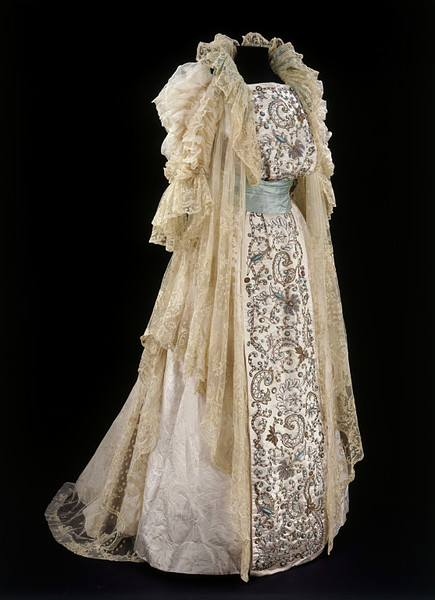
Tea gown with front panel of Indian embroidery, ca. 1900, House of Rouff (designer), collection of the V&A
As is this:
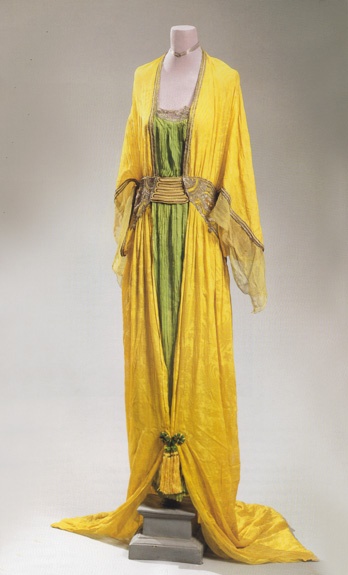
Poiret tea gown, Spring 1913. Sold at the Doyle couture auction, November 1999.
Note how different those examples are from the ones on all the sales sites? That’s because they are totally different styles of garment.
Tea gowns were made of rich, heavy fabrics, often in colours, and usually featured elaborate, trailing sleeves. You can read more about them here.
In contrast, the dresses called tea gowns by modern sellers are made in very lightweight, delicate fabrics, almost always in white. Their sleeves follow the fashionable silhouette for day sleeves of their era.
It’s a historical mis-nomer that annoys me to no end, because, by using a name that referred to a completely unique and distinct garment for the frothy white dresses, it creates confusion about what both types of garments were, what they were used for, who wore them and when, and why each was named each.
So, if all those white dresses with the lace and tucks weren’t tea gowns, what were they called in-period? Lingerie dresses. Or lingerie frocks.
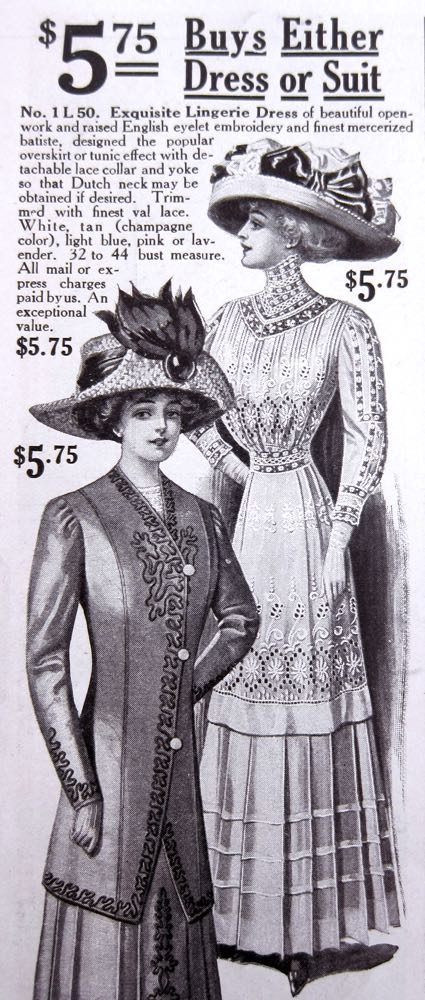
An ad for Bella Hesse garments, including a lingerie dress, featured in the June 1910 Ladies Home Journal magazine

Lingerie dresses featured in the catalogue for the National Cloak & Suit Company, Lingerie Dresses, 1908
Lingerie Frocks
Lingerie dresses were lightweight dresses, usually in white or an off-white shade, featuring pintucks, inset lace, tone-on-tone embroidery, and other delicate detailing, usually worn as summer wear in the late 19th and first quarter of the 20th century. They were usually made of cotton, and slightly less frequently in linen, with more expensive versions were made in silk. They were primarily worn by younger women.
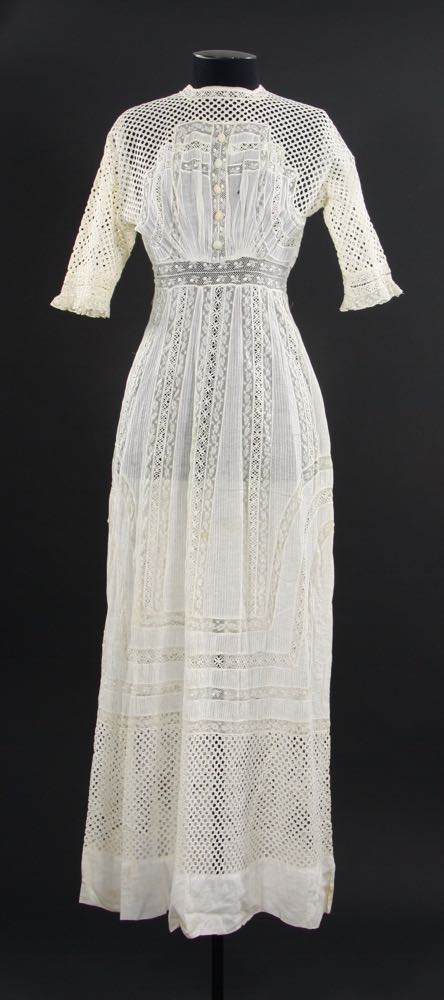
Dress, circa 1912, maker unknown. Gift of Mrs E Hofma, 1985. CC BY-NC-ND 4.0. Te Papa PC003341
They are called ‘lingerie dresses’ or ‘lingerie frocks’ because the materials used (cotton and light laces) and embellishment techniques (inset lace, faggoting, pintucks) were originally used for petticoats, chemises, and other forms of lingerie.

Dress, circa 1912, maker unknown. Gift of Mrs E Hofma, 1985. CC BY-NC-ND 4.0. Te Papa PC003341
‘Lingerie blouses’ ‘Lingerie waists’ and ‘lingerie skirts’ are blouses and skirts made of lightweight, light-coloured fabrics, featuring the same embellishment techniques. Waists were slightly more elaborate than blouses, and usually featured a supportive under-lining, though period catalogues and advertisements sometimes use the words interchangeably.
Suitable fabrics for lingerie dresses/blouses/skirts were: batiste, voile, crepe, handkerchief linen, embroidered swiss (aka dotted swiss), dimity & lawn.
Lingerie dresses were primarily used for daytime wear, and though they were also acceptable informal evening wear in summer, and were particularly suited to hot weather. Simple versions might be worn around the house, more elaborate ones were appropriate for all but the most formal daytime events.
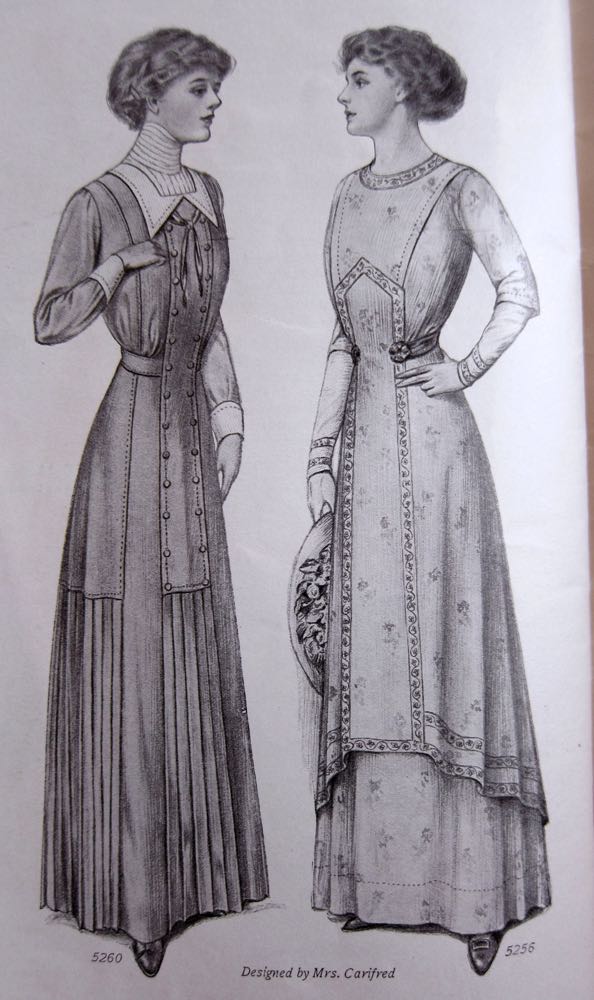
Lingerie dress patterns featured in the June 1910 Ladies Home Journal magazine

Lingerie dress patterns featured in the June 1910 Ladies Home Journal magazine
Lingerie dresses were originally intended as a fancier form of ‘wash dress’ or ‘tub frock’: garments made of materials that could, with care, be washed at home, without special equipment, without damaging them. The relative cheapness of cotton fabrics, and machine-made lace, along with their increased durability, made the dresses both economical and practical. While we might think white fabric was just asking for stains, it had the advantage over coloured fabrics, which were prone to fading, and might not be colourfast in the wash.
While the dresses were originally intended to be relatively easy care, more elaborate versions, in fancier materials, soon became available, and these were not washable.

Fabrics for making lingerie frocks & other garments, featured in the June 1910 Ladies Home Journal magazine
Standard wash frocks are different than lingerie dresses in the amount of trims and applications, and in the weight of materials: wash frocks were simpler, and of more robust fabrics. Whether washable or not, lingerie dresses had more cachet than a standard wash frock. A wash frock was worn around the house as everyday wear: elaborate lingerie dresses were suitable for graduation and confirmation wear.
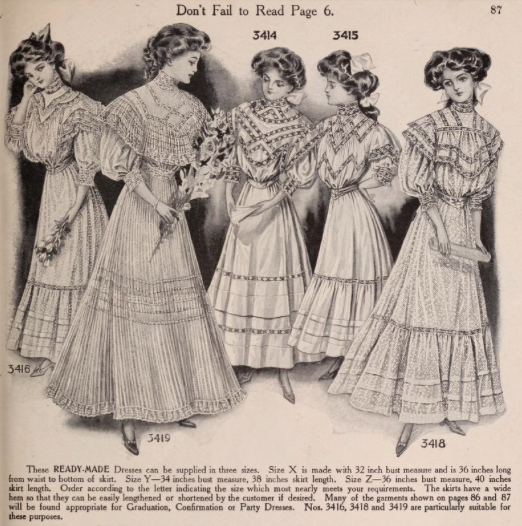
Lingerie dresses for misses, National Cloak and Suit Company, 1908

Lingerie dresses for misses, National Cloak and Suit Company, 1908
As they were both comfortable for hot weather, and formal enough to suit more elaborate occasions, lingerie dresses formed an essential piece in the wardrobe of any young lady of the Edwardian era who aspired to be well dressed. Lingerie blouses were also essential, instantly turning a simple skirt into a much more formal outfit. Wardrobe guides recommended that a girl own at least one of each the following items of outerwear:
“Middy blouse, cotton, linen or silk shirt, lingerie blouse, cotton and woolen skirts, cotton wash dress, lingerie dress, wool dress for school or street, silk dress for informal occasions, party or evening gown of cotton or silk”
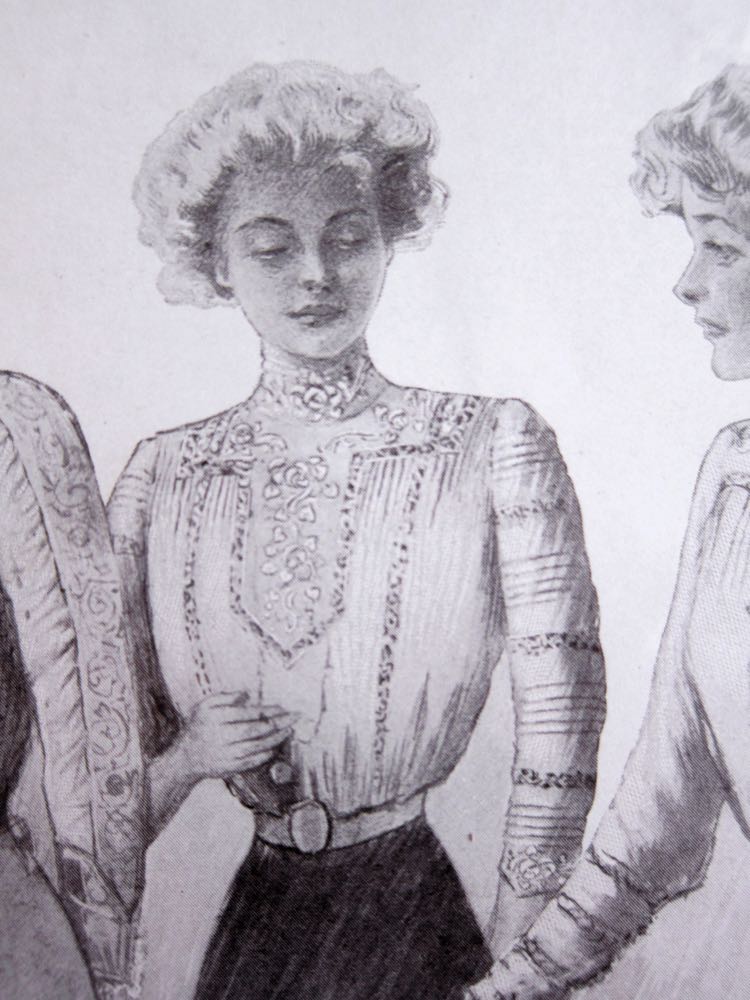
Lingerie waist patterns featured in the June 1910 Ladies Home Journal magazine
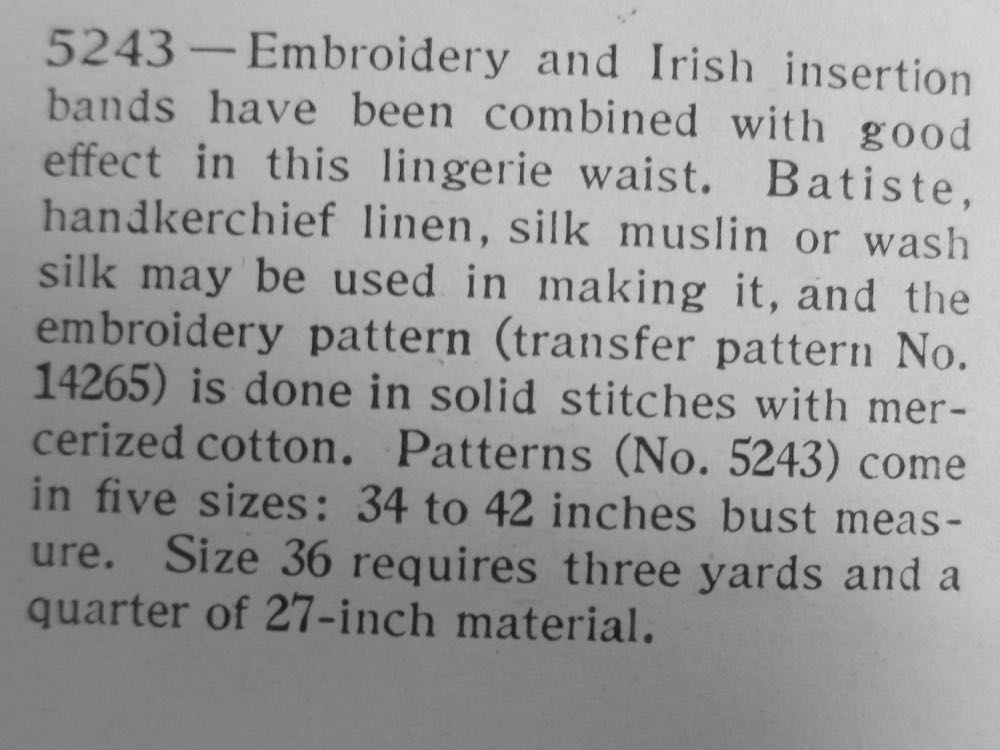
Lingerie waist patterns featured in the June 1910 Ladies Home Journal magazine
At the height of their popularity, it was possible to buy length of pre-embroidered fabric, and coordinating laces specifically to make lingerie dresses. Matching embellishments was by no-means a necessity though: Edwardian dressmakers, and even Edwardian couturiers, happily mixed and matched types, and even shades, of lace on all sorts of garments, as well as other embellishments, including lingerie dresses.
Not everyone was a fan of lingerie dresses. The July 1909 Ladies Home Journal called them “a mass of poor embroidery and objectionable cheap lace”
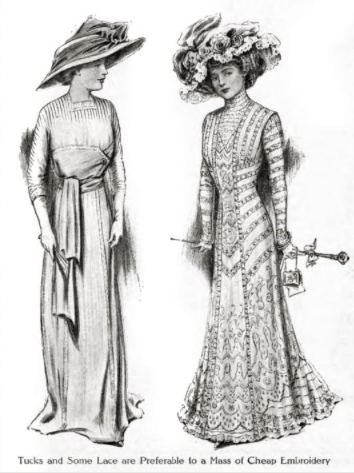
Ladies Home Journal, July 1909 contrasting a day dress in good taste, and a lingerie dress in bad taste
Dresses showing all the typical characteristics of a lingerie dress (light fabrics in light colours, lace insertion) are seen from about 1895 onwards, and were extremely popular by 1900. However, it took a while for a name to be applied to the style, and to gain widespread popularity. The term ‘lingerie dress’ (or blouse) was in widespread use in both the US and UK by 1905, and reached its height of popularity in clothing catalogues, fashion magazines, fashion columns, and sewing patterns between 1908 and 1916.
While their popularity was waning in the late ‘teens and into the 1920s, lingerie dresses continued to be made, worn, and mentioned in fashion columns well into the 1920s. Similar styles are seen in blouses into the 1930s.
Alas, I do not think my terminology point is going to cure the internet of calling lingerie dresses ‘tea gowns’ – the term is too firmly entrenched, and is probably here to stay.
But at least a few more people who are making a recreation of this style of garment, or writing a book set in the era, or a reading a book written in the era will know what to call their garment, or what was meant in the book.
And if you are selling a garment of this style, well, I don’t entirely blame you for still using ‘tea gown’ to make sure you get the hits. Hopefully you can find a way to slip in the right name too, though, and help spread the [right] word 😉
In short:
Lingerie dresses and lingerie blouses are garments made from lightweight cotton, linen and silk fabrics worn as both day and informal evening wear in hot climates from 1895-1935, but most popular from 1900-1925. They feature tucks, embroidery, and lace insertion techniques originally primarily seen in undergarments: hence their name.
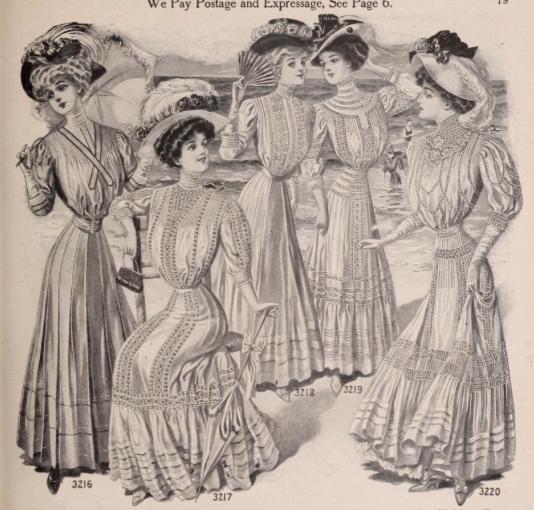
Lingerie dresses featured in the catalogue for the National Cloak & Suit Company, Lingerie Dresses, 1908
You can see more examples of lingerie dresses on my pinterest board, and some 1915 & 16 example from the Pictoral Review here.
References:
Baldt, Laura Irene. Clothing for women; selection, design, construction; a practical manual for school and home. Philadelphia: Lippincott. 1919
Complete Etiquette for Ladies & Gentlemen: A Guide to the Observances of Good Society. London: Ward Lock & Co. circa 1920.
Darnell, Paula Jean. Victorian to Vamp: Women’s Clothing 1900-1929. Reno, NV : Fabric Fancies. 2000
Fales, Jane. Dressmaking: A manual for schools and colleges. New York: Charles Schribner’s Sons. 1917.
Kemper, Rachel H. Costume. New York : Newsweek Books. 1977
Ladies Home Journal, July 1909
National Cloak & Suit Co. New York. Spring-Summer 1908
Tortora, Phyllis G. Dress, Fashion and Technology: From Prehistory to the Present. London: Bloomsbury Press. 2015

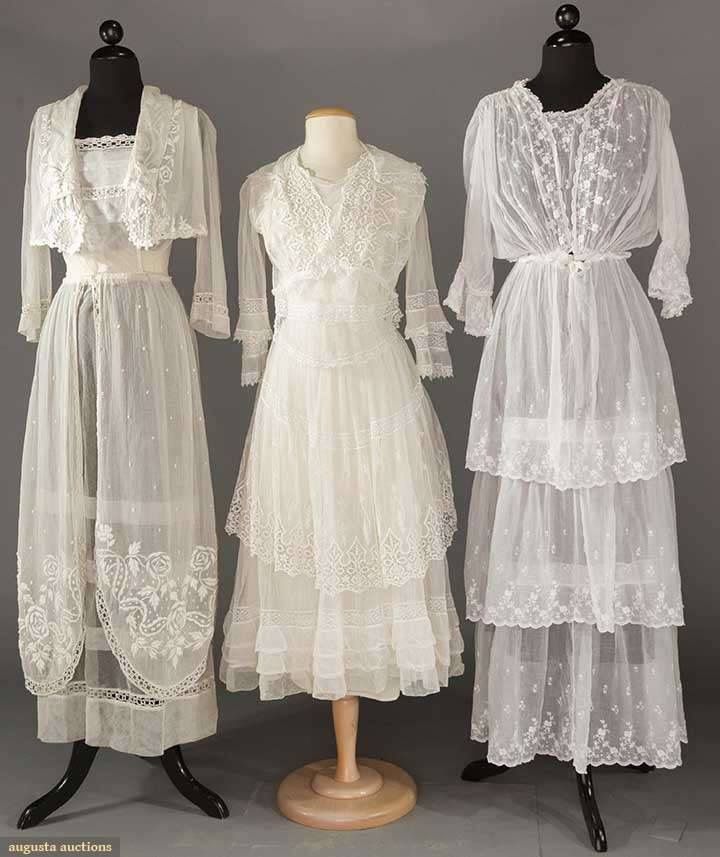
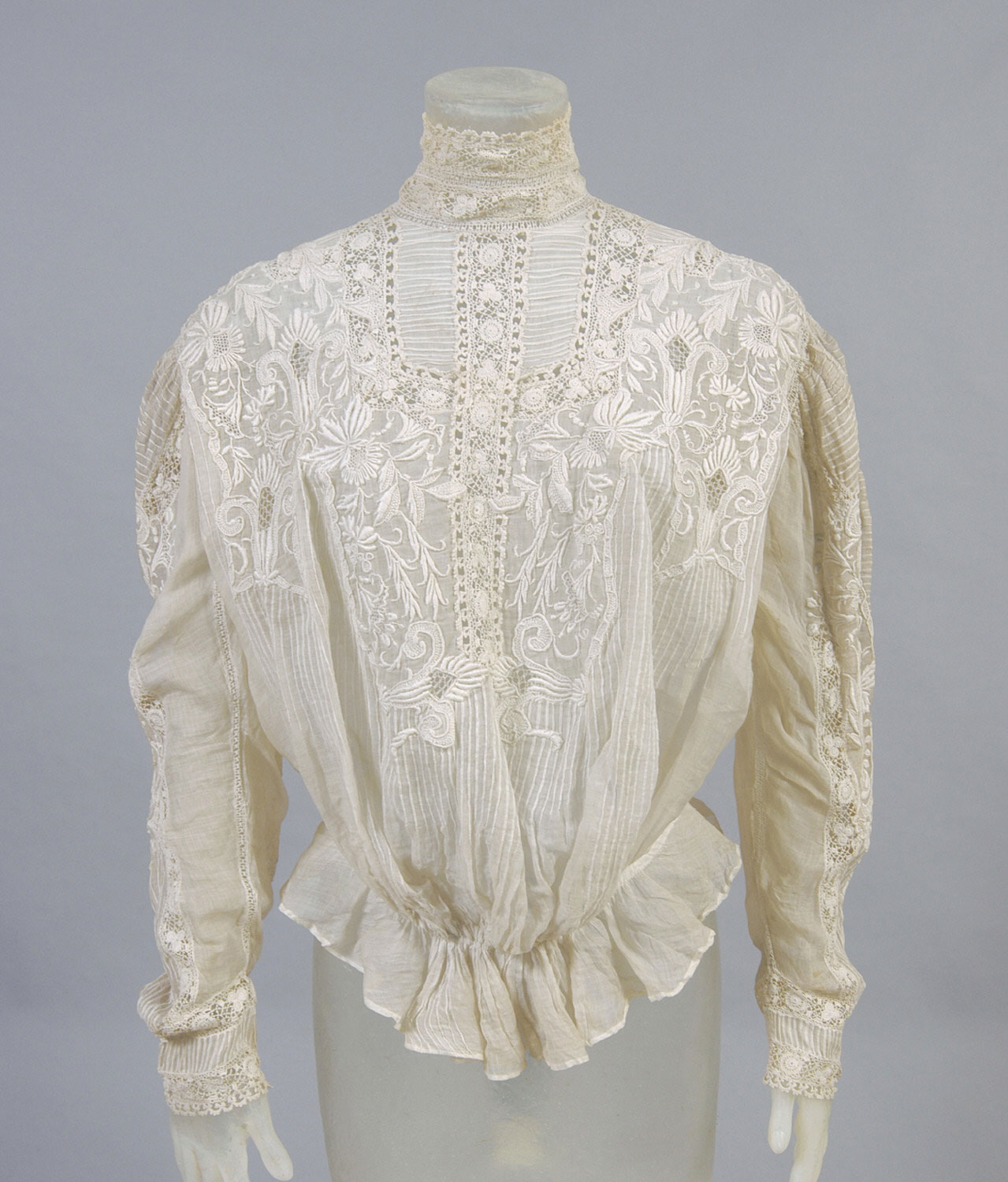

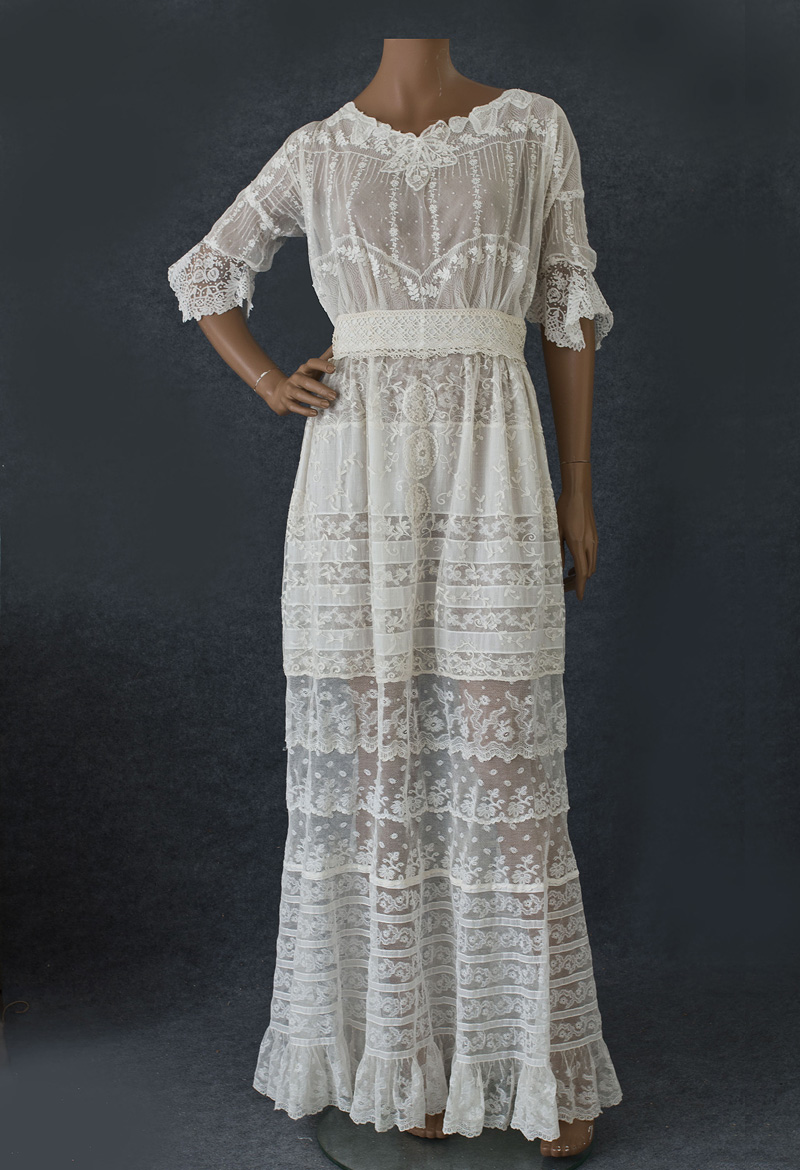
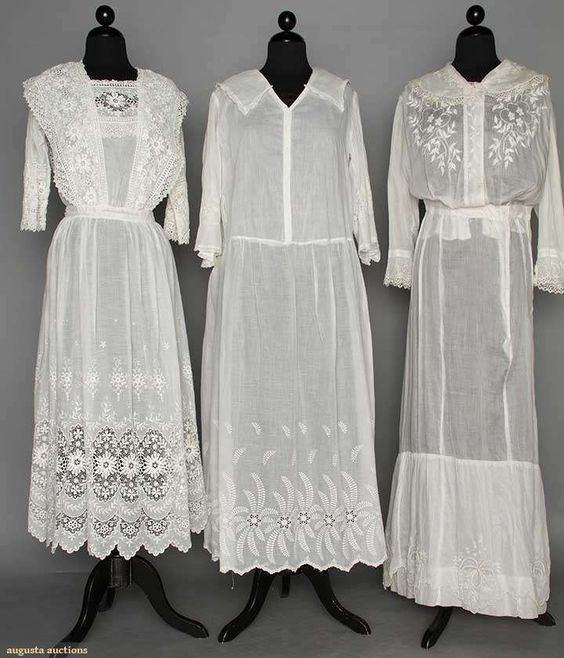
I learn so much from you!
So much solid information! Thank you!!
Guilty as charged and I won’t do it again. Honest 😉
Thank you! <3 And no need to feel guilty at all - I've used plenty of terms erroneously, because they were widespread. 😉
I always enjoy your terminology posts. Thank you for standing up for accuracy with this one! 🙂 The seemingly willy-nilly application of period terms…tends to drive me nuts!
I am particularly fond of lingerie dresses. I wish I had gotten one years ago when they still sold at more affordable prices.
What underpinnings would have been worn with these?
The usual – chemise, corset, slip or petticoat, stockings.
I saw a few mentions of wearing them over a colored under-dress, which would have looked very nice.
thank you, thank you! Misuse of terminology drives me nuts too. I called out a trader on Trade Me for describing her (lovely) dresses as 20s-style (among many other terms she’d used as tags) when nothing like them would ever have been worn in the 20s, and she just doubled-down and said that “halternecks were very popular in the 20s”. Erm, even if that was true, not like the very tightly-fitted-at-the-waist garments she was selling! I see it often on Pinterest too. So glad there are people like you who are well-informed and can give us the correct terminology (and more diplomatically than I would, too 🙂 )
Phenomenal terminology post that will be super-helpful to folks. I don’t even want to know how many hours it took you to do. 🙂
Fascinating article, and wonderful images. Thank you!
Interesting post. How widespread was the term “lingerie dress” used in the UK? The term was certainly common in the US. Do you know of any references to the use of “lingerie dress” in advertising, ladies fashion journals or suppliers in Britain during the period 1900-1920?
Hi Christina, based on the frequency of the term ‘lingerie dress’ in New Zealand advertisements of the period, and the usage of the term in UK fashion articles that were re-published in NZ papers in the 1900s-1925 period I would say that the term was equally widespread in the UK. If you follow the links throughout the article you’ll see that my period sources were balanced between Canada, the US, and NZ (which got almost all of its fashion coverage from the UK). The UK based Girls Own Paper frequently uses ‘lingerie dress/waist/frock’ in its fashion articles.
Thank you. I think the term needs a little more investigation. In my experience working with costume in the UK I can say that “lingerie dress” was almost never a term I heard used. These dresses were called afternoon tea gowns/dresses and I am not here to dispute the correct term for these garments but to find out why it appears that the term “lingerie dress” looked to be more popular in countries other than Britain. My research does not show that the term was widespread in Britain. “The term “lingerie” is of French origin meaning linen and often refers to linen goods (the original go-to fiber for undergarments).” Paris was the leader in fashion and most if not all the latest styles were publicized in articles published internationally.
They may absolutely be called afternoon tea gowns by modern costumers (by modern I mean post 1950s), but the predominant in-period term in all advertising and fashion columns I have seen come out of the UK was lingerie dress/frock/waist.
The articles and advertisements I can find out of the UK that use the words ‘afternoon tea gown’ or ‘afternoon tea dress’ in the 1890-1920 period are very scarce. None of them includes an image or a clear description. The store advertisements do group afternoon tea gowns with wrappers in their advertising, which would indicate to me they fit the description that I have used for tea gowns, and are not what I have called lingerie dresses. The few I can find with more detailed descriptions include silk and cashmere as materials, which would also suggest a very different type of garment to a lingerie dress.
More investigation is always good though! I’ve given up my subscriptions to most of the UK newspaper databases, because they were too dear and I’m not using them for current research. If you have any period articles or advertisements that use that term I’d love to see them – I’m always trying to be as clear, accurate, and precise with my terminology as possible. 🙂
I checked several French magazines and “Robe de Lingerie” is what they also call the sheer fabric with lots of lace white frocks.
What the UK and USA were calling “Tea gowns” is usually called a “Robe de Maison” in the French magazines. This translates as “house dress” but these are not a working womans “house dress”, it’s seriously fancy and for entertaining. It’s an “At Home Gown” one wears when one is having an “at home” afternoon where one entertains close friends.
Thank you! That’s super helpful!
This is so informative, thank you!
Thank you! Do you know a source of reasonably correct lawn fabric these days?
Hi Martha,
Unfortunately I don’t.
Best, Leimomi
I work in a historic house museum in the US that focuses on this time period and the family that lived there left many of these gowns. In the future I’ll be making an exhibit with them, calling them Lingerie Dresses, and inform the masses! Your agenda will spread!
I suppose Mamie Doud Eisenhower’s 1916 wedding dress was something of a lingerie dress, then! (She was a U.S. First Lady.)
https://siarchives.si.edu/collections/siris_sic_9981
I love these dresses, but never knew they were called that.
Fantastic article! This is so informative, thanks.
You’re welcome! Thank you! 🙂
so what would you wear under such sheer light dresses? petticoats and corset covers in colors? I wouldn’t imagine you’d want others to see your “unmentionables”
You’d wear petticoats and corset covers that were designed to be slightly seen through the outer garments. One of the textbooks I linked has an assignment where the students design the petticoat for a lingerie dress, and then explain how the ruffles would be seen. 🙂
Coloured petticoats and corset covers were also worn, but I’ve found some evidence that they were seen as a bit declasse or tacky – I’m not sure how widespread this feeling was, or if it was very much an ‘older person grumbling about those young people’ thing.
I just came across this information in the January, 1911 issue of The Delineator – regarding the use of light colored lawn to make slips for use under lingerie dresses (next-to-last paragraph of the first column, page 61, in case the link doesn’t work properly).
It made me think of this post, and wonder if the evidence you found of colored underthings being undesirable was from sources which were more upper-class than The Delineator’s intended audience? Or perhaps from a slightly later date, when they may have been going out of fashion?
https://babel.hathitrust.org/cgi/pt?id=iau.31858046092148;view=1up;seq=69;size=175
Excellent article. My own pet peeve is people calling drawers “bloomers”, “pantaloons”, etc.
Thanks for the links! I love period wardrobe guides. I have always fantasized about having an entire lady’s wardrobe(including accessories, hats, stockings, etc.) from a single era. Of course I want it to be a very wealthy, fashionable wardrobe, not just a “serviceable” budget one 🙂 Maybe one day I’ll be skilled enough/fast enough at sewing to make that happen.
The $150 budget/3 years wardrobe suggestions are really fascinating. Only one wool suit for 2 years! How sad having to choose just one of the many lovely styles of the era. Ditto for evening dresses. The dozens of drool-worthy costumes in fashion publications of the era would have been out of reach for most ladies. Sucks if you see a design you love but your evening dress budget has already been used up for the next 2 years. I was already aware that people had much smaller wardrobes back then(since clothing was much more expensive), but it’s easy to forget that stark reality when you spend a lot of time ogling fabulous fashion plates/extant garment. There’s so many lovely designs for any given period you forget that most women would have to limit themselves to just a few.
Also, doesn’t it seem odd that the budget allows $12 for silk petticoats but only $10 for a silk afternoon dress? I would think it would make more sense to use the $12 to get another afternoon dress or linen suit and just make do with cotton/linen petticoats. Why would a silk petticoat be such a necessity? Maybe to wear under a lingerie dress where it would presumably be visible? But again, I should think a nice cotton one would do just fine.
So interesting, you are a mine of information.
I really enjoyed reading this and being so glad I live in 2018, and not having to wear any of these in temperatures of over 30c as we are having now in the U K.
I thought I’d add a few additional details that may interest you and your readers. The French term “Robe de Lingerie” was specific, in that it referred to dresses made of fabrics typical of fine Edwardian undergarments. The word “lingerie” in French derives from “lin” (meaning linen, the textile undergarments were made of in the past). It doesn’t denote only what English calls “lingerie”, but is a rather broader term, meaning items made of fine, generally washable fabrics, or indeed the fabrics themselves (just as “soieries” refers to silks or silk articles). From my own research in French sources, “robe de lingerie” or sometimes “robe lingerie” was not always applied to the dresses you’ve described. They were just as often called “robe en linon, en batiste”, etc.
I think a previous poster is correct that “lingerie dress” may not have been widely used in the U.K. It wasn’t in Canada, dresses of this type usually being described as “fine lawn dress”, “embroidered batiste dress”, etc. The Americans adopted the term “lingerie dress” from the French and seem to have applied it almost universally in catalogues and the like, and it has stuck ever since.
A couple of small points I have to disagree on. Lingerie dresses were certainly not worn only in hot climates. They were very popular in Canada! From what I’ve researched, they were widely worn in the U.K. and other northern countries as well. However it’s true that they were almost entirely worn as a summer garment.
They were not only young women’s dresses — as with many widespread, popular fashions, they were adopted by even middle-aged women (some of whom admittedly should probably not have been wearing them, judging from photographs of the time). The fact that an unusually large number of the surviving examples are in small sizes for slender bodies is more likely the result of their having been worn on occasions like graduation, “coming-out” parties, a summer garden party, even weddings. These are sentimental attachments that provide a reason for keeping a particular garment. After nearly 25 years I still haven’t given away the little black cocktail dress I wore on my first date with my husband!
You’re right about tea gowns being different from lingerie dresses, but the interchangeable use of the two terms isn’t completely unfounded. Some tea gowns were in fact pretty close in concept and use of textiles to lingerie dresses, although as you point out the former were indoor dresses only. Tea gowns had various names in French: “toilette de five o’clock” (referring to the hour of high tea), robe or toilette d’interieur (in-home gown), or yes, even “tea-gown”! I have seen several French examples called “tea-gowns” in Edwardian publications that for all intents and purposes are “lingerie gowns”, made from typical fabrics with the same sort of extensive tucks and lace insertion. The key difference is that lingerie dresses or gowns tended to be more fitted, following the dress silhouette of the time period, whereas tea gowns, as elaborate and diaphanous as they might be, were almost always loose and flowing, often with a train to designate them as being dress of a certain formality, as opposed to deshabillee (undress, such as wrappers, peignoirs or morning gowns). Tea gowns were decidedly meant to be seen and worn in company, albeit in one’s own home.
One last small point and I’ll conclude (sorry to monopolize the space!). Lingerie dresses did come in two general types: Some were very elaborate and highly realized by skilled workers, made in small-scale workshops, often hand-embroidered, and using costly hand-made laces. Obviously these were the most expensive, and some of them are absolutely exquisite. They also tended to be the earlier dresses because the availability of skilled, mostly young women who were employed in making them began to drop off steadily after about 1907.
The second type were mass-produced (mostly sweat-shop factories in the big cities, especially in the U.S.). These were the kinds of dresses sold by mail-order catalogues that usually involved machine-made laces of varying quality, along with some pre-constructed components (such as hand-made broderie anglaise panels which were sewn into the dresses). I have examples of both kinds in my own collection, and there is a vast difference in beauty and quality between them. Once WWI began, the fine quality of the skills displayed in earlier lingerie dresses disappeared almost completely — the young women had gone elsewhere.
Thanks for listening!
Apart from vintage advertisements, would you know of any resources that describe or illustrate the difference in lingerie dress styles over time? I curate a modest antique clothing collection, and I have several boxes full of these garments with no provenance whatsoever. The cuts and details vary somewhat, and I’m having trouble determining what decade some of them are from.
Thank you!
Does anyone know anyone who sells reproduction lingerie dresses? I have scoured Etsy and Ebay, but am not thrilled with the results. Thanks in advance!